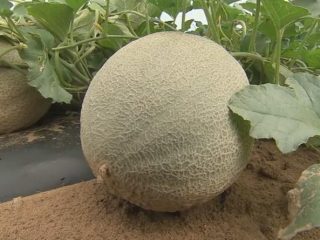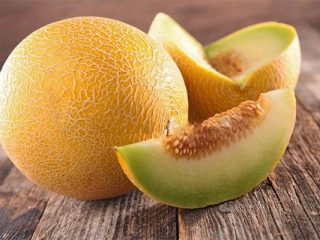Content
- 1 General description of Momordica charantia
- 2 Nutritional value, composition and calorie content of bitter melon
- 3 What are the benefits of Momordica charantia?
- 4 Use in folk medicine
- 5 Use in cooking
- 6 Preparation for medicinal purposes
- 7 Restrictions and contraindications
- 8 Rules for growing Momordica charantia
- 9 Conclusion
A plant with the exotic name Momordica charantia and with equally bizarre fruits today often decorates balconies and loggias. In Crimea and the Krasnodar Territory, it is grown in open ground, right in the garden.
This unusual-looking plant has tasty pericarps when ripe, and is also distinguished by its beneficial properties. It is believed that the Japanese love for momordica is one of the reasons for their long life expectancy.
General description of Momordica charantia
The homeland of Chinese bitter melon, or Momordica charantia, is the tropics of Asia. The plant has the appearance of a vine, reaching four meters in length.
The stem of the plant is pentagonal, with grooves and tendrils clinging to the support.
The leaves of Momordica charantia have from five to nine lobes, are heart-shaped at the base, kidney-shaped or flattened in shape, they are arranged alternately. The petiole is about 5 cm long.
Flowers with five yellow petals, unisexual, are located in the axils of the leaves.
The stalk of the plant is long.When unripe, the fruits of Momordica charantia are green and bright orange when ripe. Their surface is rough, covered with “warts” and wrinkles. The name of the plant reflects the type of its fruit: in translation Momordica charantia means “animal bite”. The shape of the fruit is cylindrical; in appearance and size they resemble cucumbers. The pulp is bitter, juicy, dense.
Inside the Momordica charantia fruit, each seed is located in a juicy pericarp, which has a ruby color and an excellent taste, reminiscent of persimmon. Seeds at the stage of full maturity are brown in color and have an oval or rectangular shape.
Nutritional value, composition and calorie content of bitter melon
Unripe fruits are eaten. Ripe ones are bitter, excluding the pericarp that envelops the seeds of Momordica charantia. To remove bitterness, the fruits are soaked and then stewed, fried, or used for canning.
The plant contains a large number of vitamins, macro- and microelements, and antioxidant substances. Vitamins in 100 g of Momordica charantia fruit include:
- B1 (thiamine) – 0.04 mg;
- B3 (niacin, nicotinic acid) – 0.4 mg;
- B6 (pyridoxine) – 0.043 mg;
- A (alpha and beta carotenes) – 0.375 mcg;
- C (ascorbic acid) – 84.0 mg.
Composition of macro- and microelements per 100 g of fruit (in mg):
- Potassium – 296;
- Calcium – 19;
- Magnesium – 17;
- Sodium – 5;
- Phosphorus – 31;
- Iron – 0.43;
- Manganese – 0.089;
- Copper – 0.034;
- Selenium – 0.2;
- Zinc – 0.8;
The energy value of 100 g of Momordica charantia is 17 Kcal. It contains:
- Proteins – 1.0 g;
- Fats – 0.17 g;
- Carbohydrates – 3.7 g;
- Dietary fiber – 2.8 g.
What are the benefits of Momordica charantia?
Due to the high content of iron, calcium, potassium, beta-carotene, Momordica charantia has a beneficial effect on the body:
- stimulating digestion;
- stimulating appetite;
- providing preventive and therapeutic effects for malaria;
- helping to treat HIV and destroy pancreatic cancer cells;
- helping to reduce blood sugar;
- improving the condition of skin and hair;
- preventing the formation of cholesterol plaques;
- relieving the condition of rheumatoid arthritis, joint pain;
- slowing down the aging process.
Daily inclusion of Momordica charantia in the diet leads to normalization of metabolic processes, stimulation of smooth weight loss, and increased energy. For this reason, the fruits of the plant are used in dietetics. In different countries of the world, Momordica charantia has been used to treat:
- gastrointestinal tract infections - in China;
- malaria, diarrhea, measles, hepatitis - in South America;
- liver diseases, snake bites - in India.
Use in folk medicine
In folk medicine of South America, all parts of Momordica charantia are used - fruits, leaves, roots, juice. Tincture and decoction are used as an anti-cold and immunomodulatory agent. Crushed leaves are applied to abscesses, wounds, and burns. The seeds are consumed raw to prevent cardiovascular pathologies and reduce the level of “bad” cholesterol.
An expectorant is prepared from the root of Momordica charantia, which helps with bronchitis. The juice of the plant is poisonous, but it is used to treat skin diseases.
Traditional healers use a decoction for nephritis, prostatitis, and kidney stones.
Momordica charantia extract destroys streptococci and staphylococci and resists HIV.
To prepare the tincture you need:
- Finely chop the fruits of Momordica charantia.
- Fill a glass container with the crushed pieces.
- Pour vodka.
- Leave in a cool, dark place for 2 weeks.
To use a prescription, you must consult your doctor.
A decoction of the seeds of Momordica charantia is used for hemorrhoids, fever, and also as a diuretic. It is prepared as follows:
- Grind 15 - 20 seeds.
- Pour boiling water over the mixture.
- Maintain on low heat for 10 minutes.
- Leave for 1 hour.
- Strain.
Use of Momordica charantia for diabetes mellitus
Official medicine does not have a consensus on the effect of preparations from Momordica charantia on blood glucose levels and the general condition of patients with diabetes. Research has revealed that the effects of the plant do not affect everyone equally. In some patients, an effect similar to the effect of insulin drugs is observed, in others it is zero. Therefore, during treatment, preparations based on Momordica charantia should be used only as an adjuvant.
A doctor's supervision is required when using the plant as a food additive or in the form of preparations based on Momordica charantia.
Use in cooking
In Asian countries, Momordica charantia is the basis of many national dishes. Due to its high protein and vitamin content, the plant is used in the preparation of soups, snacks, and salads. Young leaves and shoots contain folic acid. The fruits are consumed both unripe and ripe, but their astringency and pungency of taste are different. Large fruits are especially tasty if fried. Momordica charantia is good with stewed meat, strong broth, and in marinade. Thanks to its fruits, the taste of dishes becomes more piquant.
In Indian cuisine, bitter melon is one of the main components of curry seasoning.Together with herbs, it is added to meat and fish dishes.
They also make jam from momordiki with an unusual taste. By adding alcohol to the composition of the sweet mass, liqueurs or tinctures are obtained from the fruits.
Sweet pericarps are used in baking buns, cookies, and cakes.
Preparation for medicinal purposes
Procurement of raw materials from Momordica charantia has its own characteristics.
In May, during the formation of the plant, you should collect leaves, fruits in summer, seeds and roots in autumn.
To determine the degree of ripeness of the fruit, you should pay attention to the color of the valves from which the seeds of Momordica charantia are visible.
As with the preparation of any medicinal plant, the drying process must be organized in such a way that the raw material does not rot and at the same time does not expose it to the rays of the sun.
The stems, seeds and leaves are harvested whole. The fruits are finely chopped before drying.
All prepared raw materials should be stored in fabric or paper bags or glass containers. The properties of the plant are preserved for several years after collection:
- flowers and leaves – 2 years;
- rhizomes – 3 years;
- fruits – 4 years.
Restrictions and contraindications
Despite the beneficial medicinal properties of momordica, it has a number of contraindications for external and internal use. These include:
- pregnancy, since the plant contains substances that can lead to miscarriage;
- breastfeeding period;
- allergic reaction to the plant;
- overdose of use.
The product should also be used with great caution for stomach and duodenal ulcers.
Hypothyroidism, thyrotoxicosis, and pathology of the adrenal glands are the reason for partial restrictions on the use of Momordica charantia.
Adverse reactions to bitter melon include:
- nausea;
- vomit;
- rash;
- itching;
- sore throat;
- fever;
- hypoglycemia.
Toxins in Momordica charantia can cause coma and severe poisoning of the body.
Before the fruit appears, the leaves of the plant can cause burns. After the first fruits appear, this property disappears.
Rules for growing Momordica charantia
According to reviews from lovers of exotic plants, bitter melon can be successfully grown in a greenhouse, on a balcony, loggia, and even on a windowsill as a houseplant.
Oddly enough, the short summer of central Russia is quite enough for a tropical liana to fully ripen. For cultivation, some nuances should be taken into account.
The seeds of the plant are large – 11 by 8 mm, flat, with rounded edges and a bumpy surface. The skin is hard and dense. For germination, scarification of seeds is necessary. It consists of scratching the sharp tip of the seed with sandpaper, after which it will open and germinate more easily. The seeds are disinfected with a dark solution of potassium permanganate, where they must be placed for several hours. For germination, disinfected seeds of Momordica charantia are laid out on a damp cloth, sawdust and transferred to a warm place where the air temperature is -25 ⁰C. Under such conditions, germination is 100%.
After the first roots appear, the seeds are placed in soil or pots. Seedlings develop better if the soil contains leaf humus, peat, sand in a ratio of 2:1:0.5.
Momordica charantia requires constant feeding, to which it responds with rapid growth and development. Organic fertilizers must be added during digging - up to 10 kg per 1 square meter. Mineral - in the amount of 30 g of ammonium nitrate, 40 g of superphosphate and 30 g of potassium chloride per 1 sq. m.At high acidity values, lime is useful in the amount of 400 g per 1 square meter. m.
When growing momordica charantia on a balcony in boxes, it is worth taking into account the volume of soil and calculating the amount of complex fertilizer based on the volume of the container.
Conclusion
Momordica charantia is not a very common plant, however, it is gradually gaining popularity. This is due to its medicinal properties, taste, and interesting appearance. You should be very careful when using bitter melon, because, along with its advantages, it has many contraindications. Studying the properties, characteristics, and characteristics of the plant in combination with consulting a doctor will help make its use error-free and bring maximum benefit.
















Please tell me how to brew tea from dried momordica fruits: dose of raw materials, amount of water, dosage regimen?
Good afternoon
Tea from dried momordica (fruits or leaves) is brewed as follows:
• 5 grams of raw materials (fruits or leaves) are poured with a glass of boiling water. Five grams is approximately 1 teaspoon.
• You can leave for 15-20 minutes. The container with tea does not need to be covered with a lid.
• It is not advisable to boil the infusion, since boiling destroys most of the beneficial components.
• Tea brewed overnight has a great effect. It infuses well and acquires a more pleasant taste and aroma.
• Strain the infusion, divide into three equal portions and drink during the day in three doses.